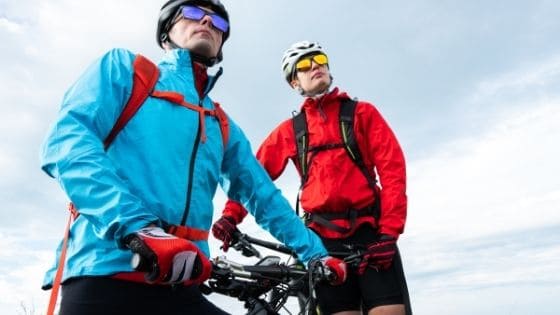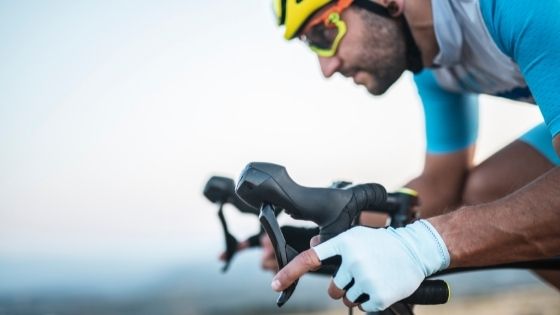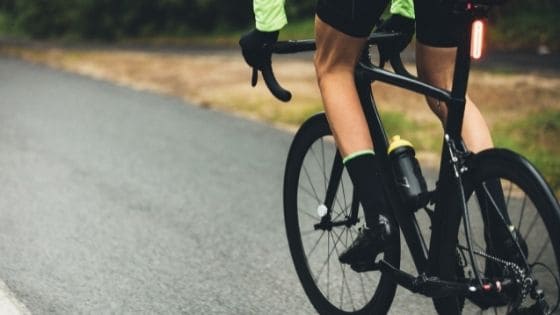
Before we head out the door on a bike ride, we want to know how long, on average, it’s going to take. Especially if you’re new to cycling. I’ve done a deep dive into the distance and how long it should take you to cycle. It doesn’t matter if you take longer than these average times because we all improve over time.
The most important thing is we get on our bikes and enjoy the time outside. Cycling is a great way to burn calories and doesn’t put added pressure on your joints and knees. Therefore, use these averages as a guide but remember you on your own journey to cycling success.

Table of Contents
How Long Does It Take To Cycle 5km?
A cyclist with an average fitness level who rides 5km on flat ground in good weather should easily cover the distance in around 12-15 minutes with an average speed of 16-20km/h (10-12 mp/h), if not faster.
Cycling 5km is relatively easy for someone with an average level of fitness and weight. You’ll also have the psychological advantage of knowing that this is a much shorter distance and will likely push your average speed to a higher level.
If you consider a relaxed approach to cycling the 5km distance, it will, of course, take a little longer. Plus, you’ll also want to consider the terrain and urban environment, and weather conditions.
To put it into some perspective, a top professional cyclist can ride at a pace of 45kmp for hours. It would take them approximately 4 minutes to cycle 5km.
Below is a table that provides the average times for both males and females of all age groups. These times are the average times but you might find you are faster or slower than these times. They are to be used as a guide because we all cycle at different speeds and intensities.
| Age | Average Time To Cycle 5km in Minutes (Males) |
| 15-19 | 12.25 |
| 20-24 | 12.00 |
| 25-29 | 12.10 |
| 30-34 | 12.15 |
| 35-39 | 12.30 |
| 40-44 | 12.50 |
| 45-49 | 13.15 |
| 50-54 | 13.25 |
| 55-59 | 14.00 |
| 60-65 | 14.55 |
| Age | Average Time To Cycle 5km in Minutes (Females) |
| 15-19 | 15.50 |
| 20-24 | 14.55 |
| 25-29 | 15.00 |
| 30-34 | 15.10 |
| 35-39 | 15.15 |
| 40-44 | 15.25 |
| 45-49 | 15.55 |
| 50-54 | 17.10 |
| 55-59 | 17.15 |
| 60-65 | 17.30 |
It’s no secret that being overweight, out of shape, and unfit costs you more than your health. It’s impacting your body confidence, ability to play with your children and the amount of energy you have. Change it all today with my online coaching.

How Long Does It Take To Cycle 10km?
A rider with average fitness using a reasonable road bike on flat terrain should be able to cycle 10km/6.2 miles in around 25-35 minutes at an average speed of 16-20km/h (10-12 miles per hour).
The most important factor to use when calculating how long it will take to ride any distance is average speed.
There are a few factors that will impact how long it takes to ride 10km, such as the terrain, how many hills there are and the surface of the road, wind speed and direction, the type of bike you are riding as well as your personal fitness level on a bike.
Another factor to consider when cycling 10 km is holding pace for a lot longer. Therefore riding 5K might feel a lot easier and faster, but the second 5K might take you a lot longer, and you will feel far more fatigued.
10k is a great distance for new cyclists and those looking to get fitter, especially if you haven’t done any cardiovascular fitness for many years.
Furthermore, 10k is a reasonable building block to move to larger distances. It’s a significant amount of time on the saddle, which will roughly take you 30 minutes and burn approximately 330 calories.
| Age | Average Time To Cycle 10km in Minutes (Males) |
| 15-19 | 24.50 |
| 20-24 | 24.00 |
| 25-29 | 24.20 |
| 30-34 | 24.30 |
| 35-39 | 25.00 |
| 40-44 | 25.30 |
| 45-49 | 26.30 |
| 50-54 | 26.50 |
| 55-59 | 28.00 |
| 60-65 | 29.10 |
| Age | Average Time To Cycle 10km in Minutes (Females) |
| 15-19 | 31.00 |
| 20-24 | 29.10 |
| 25-29 | 30.00 |
| 30-34 | 30.20 |
| 35-39 | 30.30 |
| 40-44 | 30.50 |
| 45-49 | 31.10 |
| 50-54 | 34.20 |
| 55-59 | 34.30 |
| 60-65 | 35.00 |
How Long Does It Take To Cycle 20km?
A cyclist who is riding on flat terrain using a road bike could be able to cover a 20 km distance in around 60 minutes if they were able to maintain an average speed of 16-20km/h (10-12 mp/h).
However, it is likely your average speed will decrease to around 10-14km/h. Therefore, you can expect your 20km bike ride to take anywhere from 60 minutes to 120 minutes.
Cycling 20km isn’t just calculated by doubling the time it takes to cycle 10km. Think about other factors that may come into play along your 20km route. For instance, will you be riding on flat terrain with no hills the whole way?
Are you riding from a rural to an urban environment with traffic lights and congestion? You will also want to consider your fitness level. Can you maintain an average speed of 16-20km/h (10-12 mph) for the full duration of the 20 km route?
| Age | Average Time To Cycle 20km in Minutes (Males) |
| 15-19 | 49.00 |
| 20-24 | 48.00 |
| 25-29 | 48.40 |
| 30-34 | 49.10 |
| 35-39 | 50.00 |
| 40-44 | 51.00 |
| 45-49 | 53.00 |
| 50-54 | 53.20 |
| 55-59 | 56.00 |
| 60-65 | 58.20 |
| Age | Average Time To Cycle 20km in Minutes (Females) |
| 15-19 | 62.00 |
| 20-24 | 58.00 |
| 25-29 | 60.00 |
| 30-34 | 60.40 |
| 35-39 | 61.00 |
| 40-44 | 61.30 |
| 45-49 | 62.20 |
| 50-54 | 68.40 |
| 55-59 | 69.00 |
| 60-65 | 70.00 |
Other Cycling Articles you Might Find Helpful

As we start to cycle longer distances, we tend to slow down slightly as our muscles fatigue.
20km is definitely within the endurance segment of bike riding, particularly if you’re relatively new to cycling. 20 km will take most beginners around 1 hour and 30 minutes to complete, and they would burn 1000 calories on average.
This is a significant amount of calories burned and distance travelled, making 20 km no easy feat for any cyclist regardless of experience.
Again, a top professional cyclist will cover 20km in approximately 15 to 20 minutes to put it into perspective. But remember, these individuals train every day for hours upon hours to increase the wattage and average speed.
Personally, unless my commute to work is 20 km or more per day, I wouldn’t cycle that distance every day. I might only venture this longer distance once or twice a week to increase fitness, time on the saddle, and to burn additional calories.
| DISTANCE (km) | BEGINNER (time) | AVERAGE CALORIES BURNT |
| 1km | 3 minutes | 35 calories |
| 5km | 15 minutes | 168 calories |
| 10km | 30 minutes | 336 calories |
| 15km | 1 hour 15 minutes | 840 calories |
| 20km | 1 hour 30 minutes | 1008 calories |
| 25km | 1 hour 45 minutes | 1176 calories |
| 50km | 3 hour 30 minutes | 2352 calories |
| 100km | 7 hours | 4704 calories |
Benefits Of A Bike GPS Tracker
Did you know that bike GPS trackers can help keep your exact steed, distance, and output records? The benefits of having a GPS tracker on your bike are numerous and thoroughly documented. And the data they provide are incredibly accurate.
The safety aspect includes a cycling tracking app used during rides and races to share your biking locations with other people through live GPS. The latest technology makes it much easier for you to install your bike GPS unit, whether it’s an integrated system or a standalone device.
I’ve been using the Garmin Edge 530 for over a year, and it’s a great device that never lets me down. The speed and tracking accuracy are faultless, and the Garmin app makes it easy to download and save my data. It’s also compatible with Strava. Here’s my complete owner’s review.
[amazon box=”B07QBDG3TR,B07QFG246X,B087W8TFYW” grid=”3″]
How To Improve Distance And Speed For Cycling?
Cycling is a pretty simple sport as far as physics is concerned. It’s all about weight, resistance, and strength. Approaching your goals of speed and distance should be approached slightly differently.
Here are some tips to help you improve your overall distance so you can clock up high miles on your bike.
1. Sprint Training
First, let’s look at improving speed in the capacity of sprinting a short distance on the bike.
Let’s begin with 1km.
First, try to max out your cycle speed for that 1km, then the next 1 km, reduce your speed to what you’re comfortable with.
Repeat this step over and over every time you cycle and you’ll be building a lot of body strength that will go a long way to improving your cycling speed and skill.
Next, work up to 5km. You’ll want to push your average speed higher and higher each time you attempt the 5km route, and this will involve a fair amount of muscle conditioning and training, and of course, pain.
The fastest way to improve your speed on the bike is to build a sprint-based training routine that pushes your body to increase the average speed.
You’ll want to find similar weather and road conditions and cycle at the same time each day to gauge your improvement.
Obviously, cycling at midnight with no traffic is going to be considerably faster than cycling at peak-hour in a dense urban environment.

2. Fuel Up And Regularly Stretch
You’re going to want to warm up your muscles correctly if you’re planning on doing any type of strength or distance training on the bike, so incorporate at least 10-15 minutes of stretches before and after your cycle.
Focus on the hamstring, quads, thighs, back and shoulders. Don’t forget some neck stretches and movement exercises, too as a long time in the saddle impacts your entire body.
Make sure you refuel with an electrolyte replenishing drink or a similar sports drink, and if you’re going long distances, have some slow and fast-releasing energy foods to keep you focused and energised.
[amazon box=”B075NMK9HP,B01N419CJO,B075NMK9J6″ grid=”3″]
3. Double Up The Distance
OK, so you’ve got your top speed up to around 20-25km/h, and you’re really beating the 5km route. The next step is to improve the distance that you’re cycling. The easiest way is to double your 5km route to 10km and maintain your new top average speed.
You’ll find this will be challenging at first, but within a few weeks, if you cycle every day, your muscles will be conditioned to the new 10km distance.
4. Explore More Challenging Terrain
By far, one of the easiest ways to improve your speed and distance cycling is to cycle on varied terrain. Doing a few short ascents along with bursts of downhill and sprint cycling will not only improve your cycling ability on flat terrain but will also significantly improve your fitness and overall health.
Cycling varied terrain and doing day trips cycling to new areas and towns is one of the many joys of cycling and is really something to look forward to in your cycling fitness goals.
Are you regularly cycling the same 20km cycle as your daily commute to work? OK, so why not try doing a 40km cycle to the next town or to visit friends on the weekend? Instead of admiring the mountains from a distance, why not cycle out to them and check out the terrain?
5. Join A Cycling Club
Cycling isn’t only about pushing your personal goals and fitness levels. It’s also an incredibly social sport that is ideal for all ages and skill levels of cyclists.
Joining a social cycling club is a great way to meet people with similar interests and offers exciting ways to expand your cycling skills and knowledge of the area.
Many cycling clubs also offer social rides, competitions, events, and cycle holidays to explore new areas, states, or even countries. Can’t cycle in Michigan state in the winter?
Why not hit up Malta or a Mediterranean island for a bit of cycle tourism while improving your tan?! Sounds good right! There are so many exciting places to explore and the only way to do it is to get on your bike and ride!



